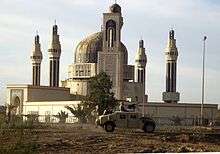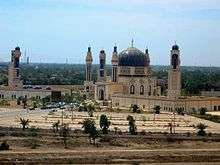Umm al-Qura Mosque

The Umm al-Qura ("Mother of All Cities") mosque in Baghdad is the city's largest place of worship for Sunni Muslims.[1] Originally called the Umm al-Ma'arik ("Mother of All Battles") mosque, it was designed to commemorate Saddam Hussein's 'victory' in the 1991 Gulf War[2] and was intended to serve as a personal tribute to Saddam himself. It is located in the Sunni-populated al-Adel area of western Baghdad.[3] Costing $7.5 million to build,[4] the mosque's cornerstone was laid on Saddam's 61st birthday on 28 April 1998. It was formally completed on 28 April 2001 in time for the ten-year anniversary of the Gulf War.[3]
Although never confirmed by his regime or himself during his lifetime, there has been speculation that it was intended to have been Saddam's final resting place.

Many architectural features of the mosque and the surrounding complex allude to either Saddam or the war (or both). It has four minarets on its perimeter, each resembling a Kalashnikov rifle barrel and standing 43 metres (141 ft) high, marking the 43 days of the Gulf War. Around the dome are another four minarets, each in the shape of a Scud missile on its launchpad standing 37 metres (121 ft) high.[5] The dome is set in the middle of a lake in the shape of the Arab world, in which was set a 7.5 metres (25 ft) wide mosaic representation of Saddam's thumbprint with an inset magnified version of his initials, made from gold.[6][7] The mosque was formerly used to display a Qur'an written in Saddam's blood.[8] The 28 fountains of the lake, the four inner minarets and the 37 m height of each minaret together represent the date of Saddam's birth - 28 April 1937. The building is constructed from white limestone with blue mosaic decorations, and red, white and black Iraqi flags are painted on the peaks of the inner minarets.[5]
Following the fall of Saddam Hussein in the aftermath of the 2003 invasion of Iraq, the mosque was taken over by a Sunni group called the Association of Muslim Scholars. It became a recruiting site and propaganda centre for the early Iraqi insurgency.[9] The association became a de facto Al Qaeda ally; its leader Harith Suleiman al-Dhari, who operated out of the mosque, is said to have played a key role in mobilizing insurgents during the 2004 fighting in Fallujah, west of Baghdad.[10] In 2007, the association was expelled by the Sunni Endowment, a quasi-governmental agency responsible for Sunni mosques in Iraq, which took control of Umm al-Qura.[3]
On 28 August 2011, the mosque was attacked by a suicide bomber during prayers, killing at least 28 people and injuring 30 more. An Iraqi member of parliament was among the dead.[11]
See also
References
- ↑ Steele, Jonathan; McCarthy, Rory. "Sunni and Shia unite against common enemy". The Guardian, 10 April 2004.
- ↑ Gregory, Derek. The colonial present: Afghanistan, Palestine, Iraq, p. 196. Wiley-Blackwell, 2004. ISBN 978-1-57718-090-6
- 1 2 3 Al Husaini, Mudhafer. "Today Was a Good Day…." At War: Notes from the Front Lines, New York Times, 28 November 2008
- ↑ Hashim, Ahmed. Insurgency and counter-insurgency in Iraq, p. 111. Cornell University Press, 2006. ISBN 978-0-8014-4452-4
- 1 2 Burns, John F. "THREATS AND RESPONSES: THE IRAQI LEADER; Hussein's Obsession: An Empire of Mosques". The New York Times, 15 December 2002
- ↑ MacAskill, Ewan. "Mosque that thinks it's a missile site". The Guardian, 17 May 2002.
- ↑ Chan, Sue. "Saddam's Mosque Of War". CBS News, January 17, 2003
- ↑ Blair, David. "Saddam has Koran written in his blood". The Daily Telegraph, 14 December 2002
- ↑ Cordesman, Anthony H.; Davies, Emma R. Iraq's insurgency and the road to civil conflict, p. 54. Greenwood Publishing Group, 2008. ISBN 978-0-313-34999-7
- ↑ Ware, Michael. "Meet The New Jihad". TIME, 27 June 2004
- ↑ "Baghdad mosque attack: Suicide bomber kills at least 28". BBC News. 28 August 2011. Retrieved 29 August 2011.
Coordinates: 33°20′16″N 44°17′46″E / 33.337711°N 44.296058°E
.jpg)
